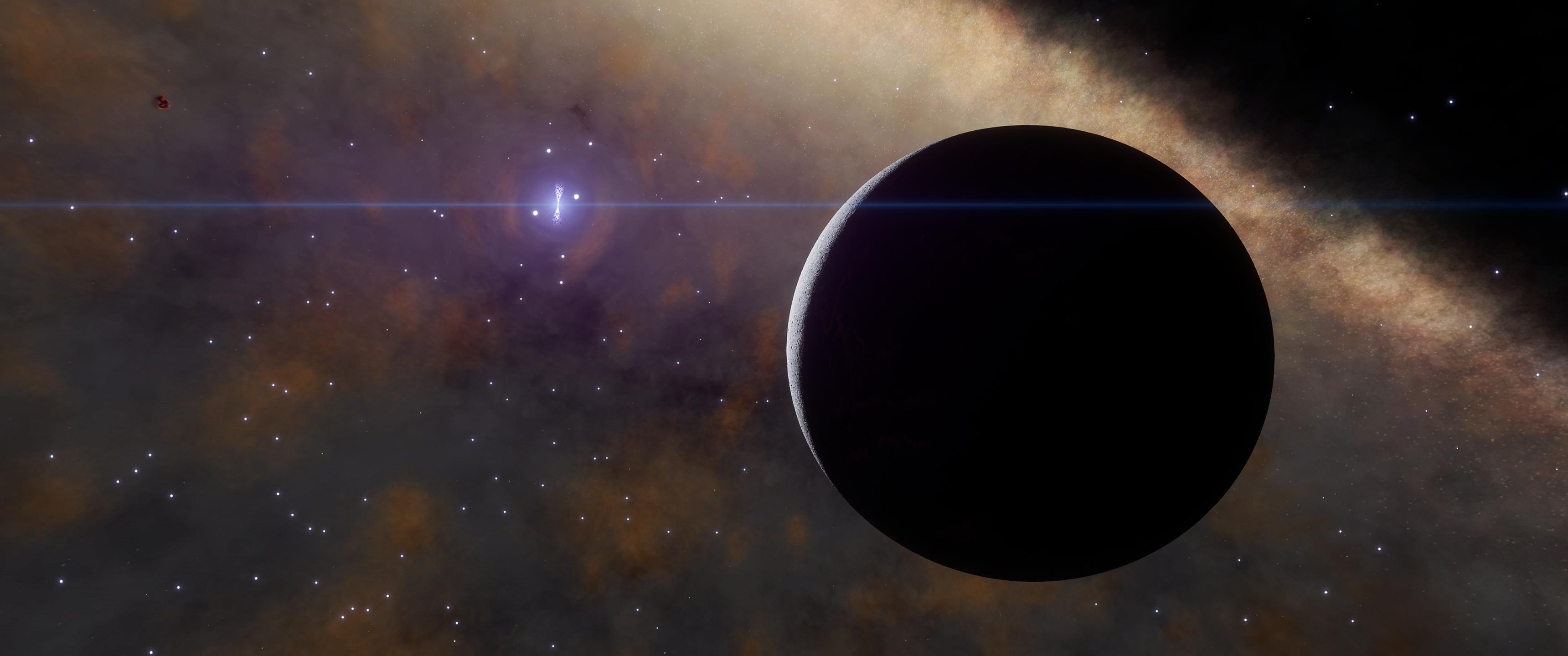

| Created: 2022-11-24 16:18:34 Last Edited: 2022-11-25 17:13:45 | |
| Discovered and Submitted by: Andrew Gaspurr | |
| Star System: | Floawns EG-Y f781 |
| Coordinates: | 1267.56 / -1253.91 / 14729.9 |
| Sol Distance: | 14,837.5 ly |
| Region: | Norma Arm |
| Category: | Sights and Scenery |
|
| |
 | |
Summary: A black hole and neutron star system with a landable planet close by, providing some spectacular vistas. | |
Description: The Floawns EG-Y f781 system was discovered a few years ago, but it has only recently gained its moniker of Aurora Atra or “Black Dawn”. The reason for the recent increase in interest lies in a spectacularly close orbit of the system's black hole and one of its two neutron star “brothers”. Their orbit puts them only 5 light seconds apart.
More than 6 billion years ago, the system was likely comprised of three extremely massive O-type or B-type stars, which subsequently went supernova. In the distant future the system will again be ruptured when the black hole and neutron star finally merge and create shockwaves of debris and radiation.
Both stellar corpses cause a massive gravitational lensing effect in their vicinity, and to further add to the system's sights, as this distortion can be seen from the surface of a landable planet nearby. Aurora Atra has a landable metal-rich iron-nickel planet (AB 1) orbiting the black hole at a mere 440 light seconds, slightly less than the distance of Earth from Sol.
With a surface gravity over 1.5 g and a scorching temperature of 1,200 Kelvin, landing and direct exposure to the neutron star's intense radiation should only be conducted under extreme “safety first” protection protocols. Even on AB 1's tidally-locked “dark side” the temperatures can reach 650 Kelvin.
As mentioned before, explorers of AB 1's surface can witness the black hole's heavy gravitational lensing effects — with the neutron star “inside” — in the sky and against the bright backdrop of the Milky Way's Norma Arm. AB 1 has one other peculiarity, which is a planetary feature: from orbit, visitors can see a particularly interesting giant rock formation which resembles a Human woman making an intricate gesture. There are a lot of creative metaphors describing the scenery, but the most prominent one has earned the formation the nickname of “the Sorceress”.
The Aurora Atra system also has a ringed type V gas giant. Due to its complex chemical processes, this more uncommon class of gas giants is generally hot enough to have silicate vapour or even liquid iron “rain” in its upper atmosphere. It still lacks enough density and mass to have evolved into a brown dwarf star, but it's nonetheless a testament to the star system's violent onslaught of radiation.
Most of the gas giant's moons are landable, and also geologically active. The most prominent moon (AB 3 a) has a slightly inclined orbit around its parent gas giant, so views are particularly rewarding here, especially as the moon has vast metallic magma fountains.
As of 24th November 3308, most of the geological sites of the system haven't been thoroughly observed and still need further analysis. | |
: | |
| ID64 Address: | 419464463309 |
| EDSM ID: | 4209095 |
EDSM Traffic Report
| Past Day: | |
| Past Week: | |
| Total: |
EDSM Estimated Value
| Scanned: | |
| Mapped: |
Nearest GEC Neighbors:
| POI Name | Distance | Rating | System |
|---|---|---|---|
| Slotin's Latte | 444.53 | 5.67 | Floawns FX‑L b36‑24 |
| Abaddon | 794.46 | 5.97 | Floawns BX‑B d13‑109 |
| Ruby In The Sky | 1,103.12 | 5.66 | Greae Phio CB‑X d... |
| Bifrost | 1,999.01 | 4.26 | Blaa Hypai KP‑E d... |
| Infinity Canyons | 2,008.14 | 4.67 | Greae Phio GH‑V b... |
| Eeshorks AA‑A h15 nebula (... | 2,246.65 | 6.08 | Eeshorks ZK‑B b2‑9 |
| Guardian Ruins ‑ Blaa Hypa... | 2,451.24 | 4.39 | Blaa Hypai LZ‑F b... |
| Blaa Hypai AA‑A h68 nebula... | 2,481.41 | 4.97 | Blaa Hypai AI‑I b... |
Nearest GMP Neighbors:
| POI Name | Distance | Rating | System |
|---|---|---|---|
| The Three Kings | 229.53 | N/A | Floawns XE‑R d4‑45 |
| The Big Three | 586.20 | N/A | Floawns RZ‑G d10‑... |
| XTE J1755‑324 | 846.41 | N/A | XTE J1755‑324 |
| Graea Phio Depot | 1,999.54 | N/A | Greae Phio OJ‑Q e... |
| The Greae Phio Stellar Forge | 2,009.75 | N/A | Greae Phio LS‑L c... |
| DSSA Void Crusaders | 2,091.52 | N/A | Greae Phio VK‑O e... |
| Aquitania | 2,095.47 | N/A | Gria Hypue UG‑S d... |
| The Anvil | 2,246.62 | N/A | Eeshorks ZK‑B b2‑9 |
Carriers Last Seen in this System:
| Callsign | Name | Date |
|---|---|---|
| KBG‑3XZ | SIR PETER BLAKE | 2024‑06‑16 08:54:11 |
Revision History:
| Edited By | Edited Date |
|---|---|
| CMDR Marx ☀ | 2022-11-25 17:13:45 |
| Andrew Gaspurr | 2022-11-24 20:09:28 |
| Andrew Gaspurr | 2022-11-24 16:18:34 |